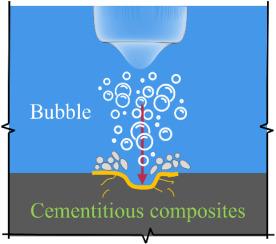高性能纤维增强胶凝复合材料的空化侵蚀行为
IF 6.1
1区 工程技术
Q1 ENGINEERING, MECHANICAL
引用次数: 0
摘要
空化侵蚀对溢洪道衬砌混凝土耐久性设计提出了重大挑战。随着低碳、高性能胶凝复合材料的出现,传统混凝土越来越多地被高性能纤维增强胶凝复合材料(HPFRCC)所取代。然而,这些新型材料的空化侵蚀性能在很大程度上仍未被探索。通过超声空化冲刷试验,系统研究了HPFRCC和高强砂浆的空化冲刷行为。HPFRCC用钢纤维增强,并包括包括三种固体废物和钛渣砂的第四系胶凝基质。研究结果表明,与砂浆相比,HPFRCC具有更低的体积/质量损失、更低的损失率、更小的分形维数和更慢的侵蚀深度发展速度。此外,钢纤维的存在和基体强度的增强导致HPFRCC相对于砂浆具有明显的空化侵蚀演化过程。钢纤维的掺入有效减缓了侵蚀深度的发展速度,而纤维-基质界面性能和纤维取向对钢纤维的效果有显著影响。HPFRCC和砂浆的抗压强度与抗空化侵蚀性能均呈正相关。而当抗压强度超过140 MPa时,抗压强度对水泥基复合材料抗空泡侵蚀性能的影响显著减弱。研究结果揭示了HPFRCC优越的抗空化侵蚀性能,为新型胶凝材料的进一步应用提供了实践见解。本文章由计算机程序翻译,如有差异,请以英文原文为准。

Cavitation erosion behavior of high-performance fiber-reinforced cementitious composites
Cavitation erosion poses a significant challenge in the durability design of spillway lining concrete. With the advent of low-carbon, high-performance cementitious composites, traditional concrete is increasingly being replaced by high-performance fiber-reinforced cementitious composites (HPFRCC). However, the cavitation erosion performance of these novel materials remains largely unexplored. This study systematically investigates the cavitation erosion behavior of HPFRCC and high-strength mortar through ultrasonic cavitation erosion tests. HPFRCC is reinforced with steel fibers and comprises a quaternary cementitious matrix that includes three types of solid waste materials along with titanium slag sand. The findings demonstrate that HPFRCC exhibits lower volume/mass loss, reduced loss rates, smaller fractal dimensions, and a slower rate of erosion depth development compared to mortar. Furthermore, the presence of steel fibers and the enhanced strength of the matrix result in a distinct cavitation erosion evolution process in HPFRCC relative to mortar. The incorporation of steel fibers effectively slows the rate of erosion depth development, while the fiber-matrix interface performance and fiber orientation significantly influence the efficacy of the steel fibers. Additionally, a positive correlation exists between the compressive strength of both HPFRCC and mortar and their resistance to cavitation erosion. However, when the compressive strength exceeds 140 MPa, the effect of compressive strength on the cavitation erosion resistance of cement-based composites diminishes significantly. The findings reveal the superior cavitation erosion resistance of HPFRCC, providing practical insights for the further application of novel cementitious materials.
求助全文
通过发布文献求助,成功后即可免费获取论文全文。
去求助
来源期刊

Wear
工程技术-材料科学:综合
CiteScore
8.80
自引率
8.00%
发文量
280
审稿时长
47 days
期刊介绍:
Wear journal is dedicated to the advancement of basic and applied knowledge concerning the nature of wear of materials. Broadly, topics of interest range from development of fundamental understanding of the mechanisms of wear to innovative solutions to practical engineering problems. Authors of experimental studies are expected to comment on the repeatability of the data, and whenever possible, conduct multiple measurements under similar testing conditions. Further, Wear embraces the highest standards of professional ethics, and the detection of matching content, either in written or graphical form, from other publications by the current authors or by others, may result in rejection.
 求助内容:
求助内容: 应助结果提醒方式:
应助结果提醒方式:


